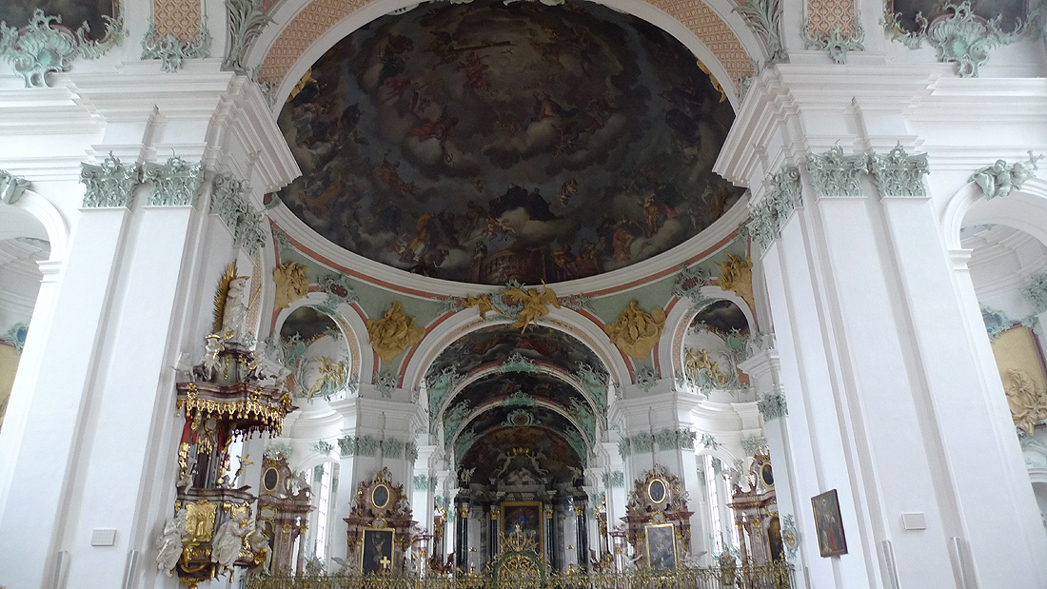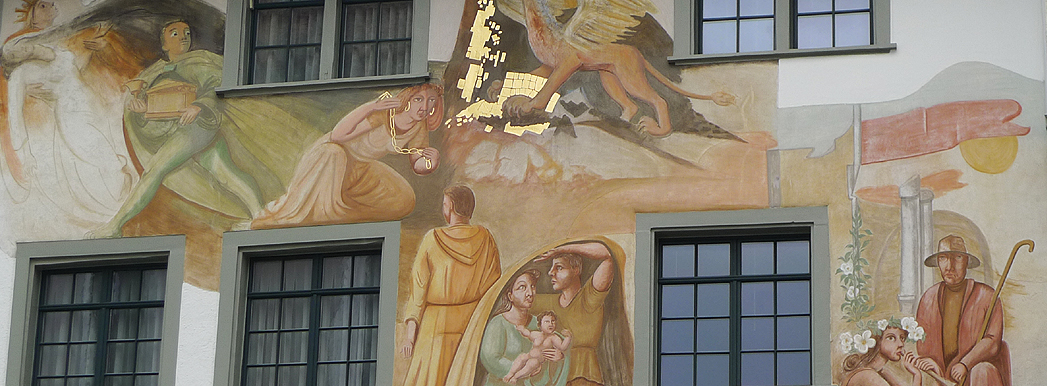|
|
 |
 |
 |
|
Indre gård/Inner
courtyard. |
 |
.jpg) |
 |
Middelalderborgen
Habsburg
(Høgeborg) på
bjerget Wülpelsberg nær
Brugg i kanton Aargau er
opkaldt efter den
europæiske
fyrsteslægt
Habsburgerne, der oprindeligt kom herfra. Huset Habsburg var et af de mest
magtfulde fyrstehuse i
Europa. Østrig blev regeret af Habsburgerne fra 1282-1918, der har regeret
som hertuger (1282-1453), ærkehertuger (1453-1804), kejsere (1804-1918)
af Østrig-Ungarn, konger
af Spanien (1516-1700)
og som tysk-romerske
kejsere i århundreder
til og med 1806, da Det
Hellige Romerske Rige af
Tysk Nation blev opløst
som konsekvens af "Slaget
ved Austerlitz i 1805".
Der har været
forskellige antagelser
omkring hvorfra
Habsburgerne nedstammer.
Ifølge "Acta Murensia"
(historiske optegnelser
fra 11. og 12.
århundrede om det
schweiziske Mittelland,
og herunder om
grundlæggelsen af
Muriklostret i kanton
Aargau) kan
Habsburgernes oprindelse
føres til
Alsace. "Acta
Murensia" nævner
Guntram den rige
(ca. 920-973) som
velynder for
grundlæggerne af
Muriklostret og som
forfader til
Habsburgerne. Guntrams
søn var grev Kanzelin af
Altenburg (d. 991), der
var far til grev
Radbot af Klettgau
(ca. 985-1045), der
byggede Habsburg og gav
det navn. Radbot var
forfader til Rudolf 1.
(1218-1291), der var den
første Habsburger, der
blev konge af det
Tysk-Romerske Rige. Hvis
"Acta Murensia" taler
sandt nedstammer
Habsburgerne fra en
gruppe af alsaciske
aristokrater. |
 |
|
Habsburgerne stamsæde
blev grundlagt som en
dobbeltborg.
Den del af borgen, som er
delvist bevaret, er
et selvstændigt
borgkompleks med en
indre gård. Borgens
ældst bevarede bygning
er det lille tårn,
der er opført før år
1100. Omkring
1200-tallet blev borgen
udvidet med det store
tårn mod vest og med
en ringmur med et
flankeringstårn på den
nordlige skrænt.
Hovedparten af Habsburg
er i dag i ruiner. |
 |
The medieval castle
Habsburg
(hawks's castle) at the
mountain Wülpelsberg
near Brugg in canton of
Aargau is named after
one of the most
influential royal houses
of Europe, The House of
Habsburg. The castle was
the original seat of the
Habsburg family. Austria
was ruled by the
Habsburg dynasty from
1282 to 1918. They
became emperors of
Austria and of the Holy
Roman Empire of the
German Nation. The Holy
Roman Empire was
abolished in the
aftermath of the
Napoleonic Wars in 1806.
Various hypotheses have
been suggested
concerning the origins
of the Habsburgs.
According to "Acta
Murensia", a chronicle
dealing with the
founding of the Muri
Abbey, the search for
the origins of the
Habsburgs would lead to
Alsace.
It names Guntram the
Rich (c. 920-973) as
the patron of the
founders of the Muri
Abbey and as the
ancestor of the
Habsburgs. Guntram's son
was Count Kanzelin von
Altenburg (d.
991) and his son
Count Radbot
(c. 985-1045) built
Habsburg Castle and
named it. Radbot in
turn was an ancestor of
Rudolf I (1218-1291),
the first of the
Habsburgs to become King
of the Romans. If "Acta
Murensia" is correct,
the Habsburgs were
descended from a group
of Alsatian aristocrats. |
 |
|
The ancestral seat of the Habsburg Dynasty
was founded as a double castle.
The part of the castle, which is partially
preserved, is an independent castle complex
with an inner courtyard. The oldest
preserved building is the small tower,
built before 1100. Around 1200 the castle
was expanded with the big western tower
and a defensive wall with a flanking tower.
Today most of the castle lies in ruins. |
 |
|
|
|
|
1 |
Træsnit af Huset Habsburgs gamle våbenskjold
fra
Johann Stumpfs krønike,
1547/48.
Johann Stumpf (1500-ca.1578) var en tysk teolog,
topograf og historiker, der boede i Schweiz det
meste af sit liv og skrev en omfattende krønike om
Schweiz' historie og landets topografi:
"Gemeiner
loblicher Eydgnoschafft Stetten, Landen
und Völckeren Chronick
wirdiger Thaaten
Beschreybung",
1547/48.
Woodcut of the old coat of arms of the dynasty of
Habsburg
from the
Chronicle of Johann Stumpf,
1547/48.
Johann Stumpf (1500-c.1578) was a German theologian,
map-maker and historian who spent much of his life
in Switzerland and authored an extensive chronicle
of Swiss history and description of its topography:
"Gemeiner
loblicher Eydgnoschafft Stetten, Landen
und Völckeren Chronick
wirdiger Thaaten
Beschreybung",
1547/48. |
|
2 |
Habsburg våbenskjold udført af den østrigske våbenmaler Hugo Gerhard Ströhl (1851-1919) er billedtavle II fra Ströhls østrig-ungarske våbenrulle, 1890.
I våbenskjoldet ses en rød løve med en blå
krone på gylden baggrund, herover ses en
turneringshjelm og herover igen en løve med
en påfuglefjerbesat rygkam.
The Habsburg coat of arms by
the Austrian heraldist Hugo
Gerhard Ströhl (1851-1919) is a plate II
from Ströhl's Austro-Hungarian Armorial,
1890. The coat of arms consists of a red
lion with a blue crown
on a golden background,
a tournament helmet
and again a lion
adorned with peacock feathers. |
|
3 |
Det store tårn er en fireetagers bygning hvis højde er ca. 20 meter. Tårnet var tilgængeligt via en førstesals indgang på dets østlige side. Væggene på tredjesalen havde oprindeligt huller, der formentlig skulle holde overliggere, der skulle støtte flytbare trævægge. Det tyder på, at tårnet var et forsvarstårn snarere end et beboelsestårn. Kaminen på andensalen var derfor en varmekilde og ildsted for soldaterne i tårnet og ikke beregnet til at opvarme en stue. Det nuværende post-middelalderlige interiør består af bræddegulve og bjælker.
The big tower is a four-storey building. Its total heights is approximately 20 metres.
The tower was accessed via a
first-floor entrance on its eastern side.
The walls of the third storey originally had
holes. These were probably meant to hold
beams to support a demoutable timber
brattice. This suggest that the tower was a
donjon rather than a residential tower. The fireplace on the second floor was therefore a source of heat and a hearth for the garrison in the tower as opposed to heating
a living room. The current interior fittings
consisting of board floors and beams
are post-medieval installations. |
|
4 |
Rekonstruktion af Habsburg, o. 1250/Reconstruction of Habsburg, about 1250. |
|
 |
|
|
|
1 |
Akvarel af
den schweiziske glasmaler og
bogillustrator Hans Ulrich Fisch, 1634. Første
realistiske skildring af Habsburg. Til højre ses den
bageste borg, til venstre (adskilt af en grøft)
slotsgården med det toetagers borgkapel og resterne
af ringmuren. I forgrunden er floden Aare, og i
baggrunden ses borgen Brunegg.
Watercolour by the Swiss stained
glass painter and book illustrator Hans Ulrich Fisch,
1634.
Earliest realistic depiction of Habsburg. On the right the rear
castle, to its left (separated by a
ditch) the castle courtyard with the
two-storey castle chapel and the
remnants of the curtain wall. In the
forground is the Aare River, with
the castle of Brunegg in the
background. |
|
2 |
Habsburg, udsigt til bjergene: Wetterhörner, Mönch, Eiger, Jungfrau, Breithorn, Blümlisalp.
Habsburg, view of the mountains: Wetterhörner, Mönch, Eiger, Jungfrau, Breithorn, Blümlisalp. |
|
 |
|
|
 |
|
|
|
1 |
Zar Alexander 1. (1777-1825)/Tsar
Alexander I (1777-1825). |
|
2 |
Kejser Franz 1. af Østrig (1768-1835)/Emperor Francis I of Austria (1768-1835). |
|
3 |
Kronprins Ferdinand (1793-1875)/Crown Prince Ferdinand (1793-1875). |
|
4 |
Johannes hertug af Effingen (1773-1840)/Johannes Duke of Effingen (1773-1840). |
|
5 |
Johann Heinrich Rothpletz (1766-1833) var rådmand i kanton Aargau fra 1815-31.
Johann Heinrich Rothpletz (1766-1833) was councillor in the Canton of Aargau from 1815-31. |
|
 |
|
|
|
1 |
Karl von
Reding (1779-1853), politiker og dommer/Karl
von Reding (1779-1853), politican and judge. |
|
2 |
Hertug Johann af Østrig (1782-1859)/Johann Duke of Austria (1782-1859). |
|
3 |
Albrecht Rengger (1764-1835), politiker og læge/Albrecht Rengger (1764-1835), politican and doctor. |
|
4-5 |
Udstillingen "Ein Kaiser zum Frühstück" (en kejser til morgenmad), 2017, viser et kongeligt festtaffel.
The exhibition "Ein Kaiser zum Frühstück" (An emperor for breakfast), 2017, shows a royal banquet. |
|
 |
|
Katedralen i St. Gallen/Cathedral of St Gall |
 |
|
 |
 |
|
|
|
 |
  |
|
|
 |
|
Drop Down Menu
|
 |
|

